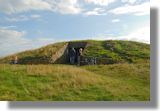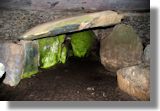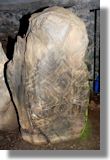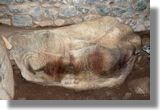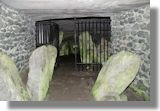Barclodiad y Gawres
Sited on a coastal headland overlooking Porth Trecastell (Cable Bay), this burial chamber is one of two on Anglesey that have been reconstructed and covered with their original mounds (the other being Bryn Celli Ddu). Its name means "the Giantess's Apronful", which comes from an ancient legend where a giant woman, carrying a number of large stones in her apron, drops them in a pile on the ground. In Neil Bayne's 1912 description of the site it indeed seemed to be just a pile of stones, so much so that he thought it was just a collection of cists rather than a full burial chamber. However, excavations in 1952-53 showed it to be an altogether more impressive structure.
These excavations, carried out by Thomas Powell and Glyn Daniel, revealed it to be a cruciform (cross-shaped) passage tomb. This consists of a passage into a central chamber, with three smaller chambers branching off. This type of tomb is also commonly found in Ireland, for example the famous Newgrange, which suggests links between the Neolithic people of these two islands.
However, the greatest find of these excavations was a number of decoratively carved stones, with spirals, chevrons and zig-zags incised into them. These again are similar to those found in Newgrange and other Irish tombs. Powell and Daniel uncovered five of these, including the most impressive "Stone 22" shown here. Faint carvings were discovered on a sixth stone in 2001.
The excavations also revealed evidence of the site's use for burials and rituals. The undisturbed cremated remains of two people were found in one side chamber, and traces of bone in the others. Pottery sherds and pins made of polished antler were also found. The central chamber does not seemed to have been used for burials, but instead for rituals. Fires had been lit here and allowed to burn for a long time. Most intriguingly, mixed in with the fire remains were unburnt bones from a number of different animals, including wrasse, eel, frog, toad, snakes, mice and hares, suggesting the fire was quenched with a "witches brew" of a stew. This was then carefully covered with pebbles and limpet shells.
After the excavations the chambers were reconstructed, roofed with concrete and covered by a grassy mound, to recreate as best as possible the original appearance. To protect the interior a locked gate was added to the entrance. Visitors used to be able to visit by collecting the key from a nearby shop, but after the decorated stones were vandalized by spray paint, access is now only possible during scheduled open days or by special appointment, accompanied by staff. See Cadw's web site for details.
Return to Prehistoric monuments of Anglesey
Location map
View Larger Map
See the locations of all the prehistoric monuments mentioned on this site.
Aerial image
A new book by Warren Kovach, author of this web site


